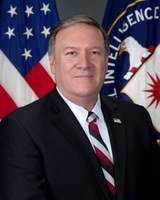
WASHINGTON: Congress has slapped DoD with a prohibition on spending any fiscal 2020 funds for buying or fielding intermediate-range ballistic or cruise missiles despite US withdrawal from the Intermediate-Range Nuclear Forces (INF) Treaty.
The prohibition was agreed by the House and Senate in the 2020 National Defense Authorization Act (NDAA) late on Monday — the night before one of the competitors in the Army’s pivotal contest for a next-generation long-range missile successfully tested a system . that eventually the service hope to reach a minimum range of 500 kilometers, above the INF’s range cap. Of course, the missile being tested is still in development so it would not violate the NDAA restrictions.
Under the NDAA language, DoD can continue to spend research and development funds on intermediate-range missiles (with ranges between 500 and 5,500 kilometers) — at least for the next year. Meanwhile, DoD must submit a to Congress that includes an analysis of alternatives (AOA) to an INF-busting missile, examines potential basing options in Europe, and perhaps most importantly (and potentially difficult for DoD), a review of consultations with allies on the US plans.
The provision is actually significantly watered down from the House version, which would have blocked Army testing of a new long-range Precision Strike Missile capable of flying beyond the INF range cutoff.
As Sydney reported, Lockheed Martin yesterday successfully tested their variant of the Precision Strike Missile, meant to replace the Army Tactical Missile System (ATACMS). Raytheon, with its DeepStrike Missile, is the other competitor in the competition, under which the Army is seeking to deploy by 2023 or 2025 a missile with a range of at least 500 kilometers (310 miles) as a first iteration of the Precision Strike Missile. Follow-on iterations could have even longer ranges, and are being designed to have vastly improved tracking and targeting capabilities.
The missiles are aimed at aimed at Russian anti-aircraft radars and Chinese ships in the Pacific. The program is part of the Army’s No. 1 modernization priority, Long-Range Precision Fires, which in turn serves the rapidly evolving concept of Multi-Domain Operations, in which US ground forces reach out from land to assist the Air Force and Navy in new and lethal ways.
Pushed by Adam Smith, chairman of the House Armed Services Committee, lawmakers also are demanding that the Trump Administration provide Congress with 120 days of notice before it withdraws from a pair of nuclear arms control agreements, as well as give lawmakers an assessment of the likely reaction of NATO allies to any withdrawal.

The NDAA agreement further “requires an independent study on the policy of no-first-use of nuclear weapons, and a report on military-to-military dialogue with foreign countries to reduce the risk of miscalculation, unintended consequences, or accidents that could precipitate a nuclear war,” according to a summary released Monday night by House Republicans.
Congressional Democrats and arms control supporters have been dismayed by the Trump Administration’s opposition to arms control, spearheaded in large part by ousted National Security Advisor John Bolton. Besides withdrawing from the INF Treaty in September (citing Russian violations that Moscow has denied), the White House plans to leave the 2002 Open Skies Treaty, and has been laying the groundwork for abandoning the 2010 New START Treaty.
Open Skies, first championed by President Dwight Eisenhower, allows the US and Russia to conduct unarmed inspection flights over each other’s territory to assess nuclear and conventional military facilities. Military and intelligence officials widely favor the treaty because it provides the rare chance to gather a wide array of data without obvious interference and provides transparency, which makes miscalculation less likely.
The New START Treaty, negotiated with Russia by the Obama Administration, is a follow-on to the legendary START treaties that put a lid on the nuclear arms race during the Cold War. New START limits Russia and the US each to no more than 1,550 deployed strategic warheads and 700 deployed strategic delivery vehicles (meaning ICBMs, submarines and bombers). The White House has been waffling on whether to extend the treaty for five more years — which it can do by a simple agreement with Russia — when it lapses in 2021.
Secretary of State Mike Pompeo reiterated yesterday the Trump Administration position that New START should be expanded to include tactical nuclear weapons and other new nuclear systems, as well as rope in China’s nuclear arsenal. He spoke at a press conference with his Russian counterpart Sergei Lavrov .

John Beyrle, who was appointed in 2008 by President George W. Bush as ambassador to Russia, told reporters in a phone call sponsored by the Arms Control Association that, while changes are needed, letting New START expire would be “a pretty solid punch to the solar plexus of strategic stability.
“If the treaty expires, we lose the inspection, the monitoring, the data exchange mechanisms that verify the compliance with the nuclear reductions,” said Beyrle. He further noted that China, which has only a few hundred nuclear weapons compared to the thousands deployed by the US and Russia, “have made it very, very clear that they’re not interested” in joining the treaty.
Beijing will not participate in trilateral nuclear arms control talks unless “the U.S. agrees to reduce its arsenal to China’s level or agrees for China to raise its arsenal to the U.S. level,” Fu Cong, director of the arms control department at China’s Foreign Ministry, said Nov. 8.
Russian President Vladimir Putin said last Thursday at a press conference in Moscow that Russia would be glad to extend New START without preconditions. Further, Russia’s Foreign Ministry formally announced last month that two new weapon systems the Trump White House has said would fall outside the treaty — Sarmat, a new intercontinental ballistic missile, and Avangard, a hypersonic glide vehicle — would actually be covered by New START.
Lynn Rusten, senior director for arms control and verification in Obama’s National Security Council, told Breaking D on Dec. 4 that “President Trump can take credit for getting the Russians to agree that these new systems will be covered by the treaty.”
As Breaking D readers know, US allies have been outspoken about their concern that the US may walk away from New START. Even the United Kingdom, which traditionally mirrors Washington on national security issues, has said that it intends to stand by the treaty.
As for Open Skies, the chairman of the House Foreign Affairs Committee, Rep. Eliot Engel, said in an Oct. 7 letter to new National Security Advisor Robert O’Brian that withdrawal would be “reckless” and damage US national security by removing a key tool for watching Russian military activities including in Ukraine. “NATO allies and partners, and Ukraine in particular, have repeatedly stressed the importance of the Open Skies Treaty in their efforts to monitor Russia’s military,” he said.

